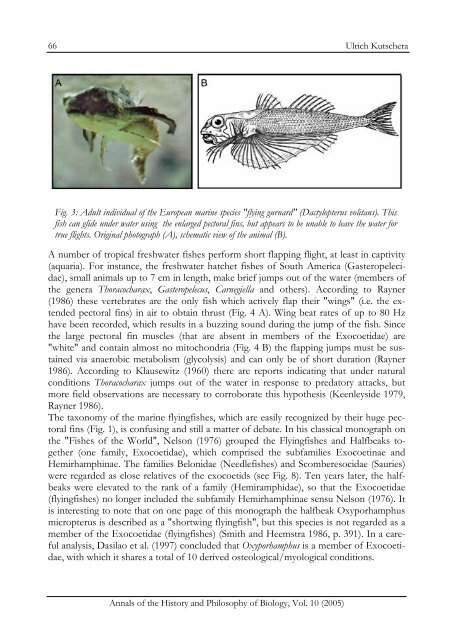Annals of the History and Philosophy of Biology
Annals of the History and Philosophy of Biology
Annals of the History and Philosophy of Biology
Create successful ePaper yourself
Turn your PDF publications into a flip-book with our unique Google optimized e-Paper software.
66<br />
<strong>Annals</strong> <strong>of</strong> <strong>the</strong> <strong>History</strong> <strong>and</strong> <strong>Philosophy</strong> <strong>of</strong> <strong>Biology</strong>, Vol. 10 (2005)<br />
Ulrich Kutschera<br />
Fig. 3: Adult individual <strong>of</strong> <strong>the</strong> European marine species "flying gurnard" (Dactylopterus volitans). This<br />
fish can glide under water using <strong>the</strong> enlarged pectoral fins, but appears to be unable to leave <strong>the</strong> water for<br />
true flights. Original photograph (A), schematic view <strong>of</strong> <strong>the</strong> animal (B).<br />
A number <strong>of</strong> tropical freshwater fishes perform short flapping flight, at least in captivity<br />
(aquaria). For instance, <strong>the</strong> freshwater hatchet fishes <strong>of</strong> South America (Gasteropelecidae),<br />
small animals up to 7 cm in length, make brief jumps out <strong>of</strong> <strong>the</strong> water (members <strong>of</strong><br />
<strong>the</strong> genera Thoracocharax, Gasteropelecus, Carnegiella <strong>and</strong> o<strong>the</strong>rs). According to Rayner<br />
(1986) <strong>the</strong>se vertebrates are <strong>the</strong> only fish which actively flap <strong>the</strong>ir "wings" (i.e. <strong>the</strong> extended<br />
pectoral fins) in air to obtain thrust (Fig. 4 A). Wing beat rates <strong>of</strong> up to 80 Hz<br />
have been recorded, which results in a buzzing sound during <strong>the</strong> jump <strong>of</strong> <strong>the</strong> fish. Since<br />
<strong>the</strong> large pectoral fin muscles (that are absent in members <strong>of</strong> <strong>the</strong> Exocoetidae) are<br />
"white" <strong>and</strong> contain almost no mitochondria (Fig. 4 B) <strong>the</strong> flapping jumps must be sustained<br />
via anaerobic metabolism (glycolysis) <strong>and</strong> can only be <strong>of</strong> short duration (Rayner<br />
1986). According to Klausewitz (1960) <strong>the</strong>re are reports indicating that under natural<br />
conditions Thoracocharax jumps out <strong>of</strong> <strong>the</strong> water in response to predatory attacks, but<br />
more field observations are necessary to corroborate this hypo<strong>the</strong>sis (Keenleyside 1979,<br />
Rayner 1986).<br />
The taxonomy <strong>of</strong> <strong>the</strong> marine flyingfishes, which are easily recognized by <strong>the</strong>ir huge pectoral<br />
fins (Fig. 1), is confusing <strong>and</strong> still a matter <strong>of</strong> debate. In his classical monograph on<br />
<strong>the</strong> "Fishes <strong>of</strong> <strong>the</strong> World", Nelson (1976) grouped <strong>the</strong> Flyingfishes <strong>and</strong> Halfbeaks toge<strong>the</strong>r<br />
(one family, Exocoetidae), which comprised <strong>the</strong> subfamilies Exocoetinae <strong>and</strong><br />
Hemirhamphinae. The families Belonidae (Needlefishes) <strong>and</strong> Scomberesocidae (Sauries)<br />
were regarded as close relatives <strong>of</strong> <strong>the</strong> exocoetids (see Fig. 8). Ten years later, <strong>the</strong> halfbeaks<br />
were elevated to <strong>the</strong> rank <strong>of</strong> a family (Hemiramphidae), so that <strong>the</strong> Exocoetidae<br />
(flyingfishes) no longer included <strong>the</strong> subfamily Hemirhamphinae sensu Nelson (1976). It<br />
is interesting to note that on one page <strong>of</strong> this monograph <strong>the</strong> halfbeak Oxyporhamphus<br />
micropterus is described as a "shortwing flyingfish", but this species is not regarded as a<br />
member <strong>of</strong> <strong>the</strong> Exocoetidae (flyingfishes) (Smith <strong>and</strong> Heemstra 1986, p. 391). In a careful<br />
analysis, Dasilao et al. (1997) concluded that Oxyporhamphus is a member <strong>of</strong> Exocoetidae,<br />
with which it shares a total <strong>of</strong> 10 derived osteological/myological conditions.

















